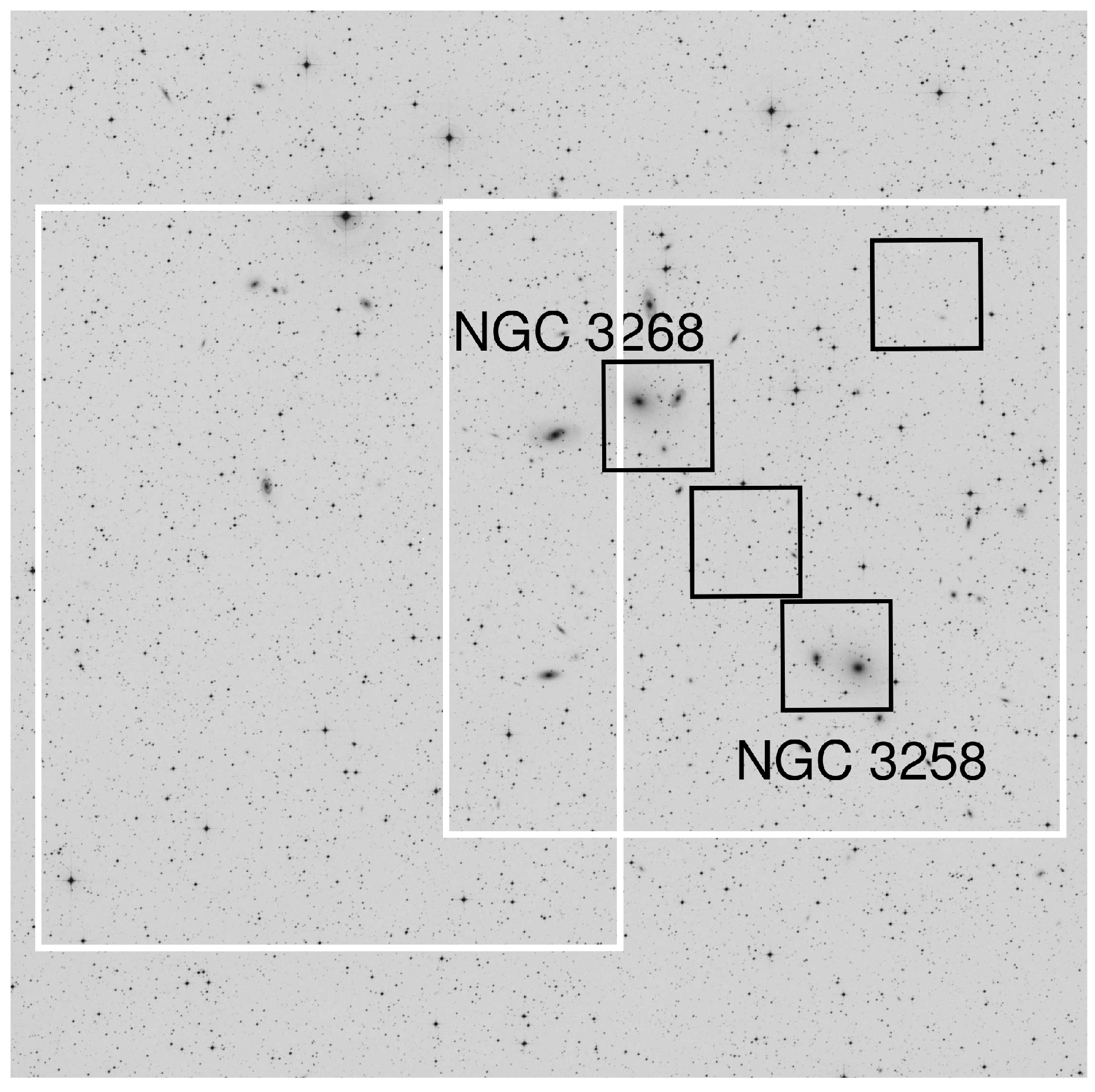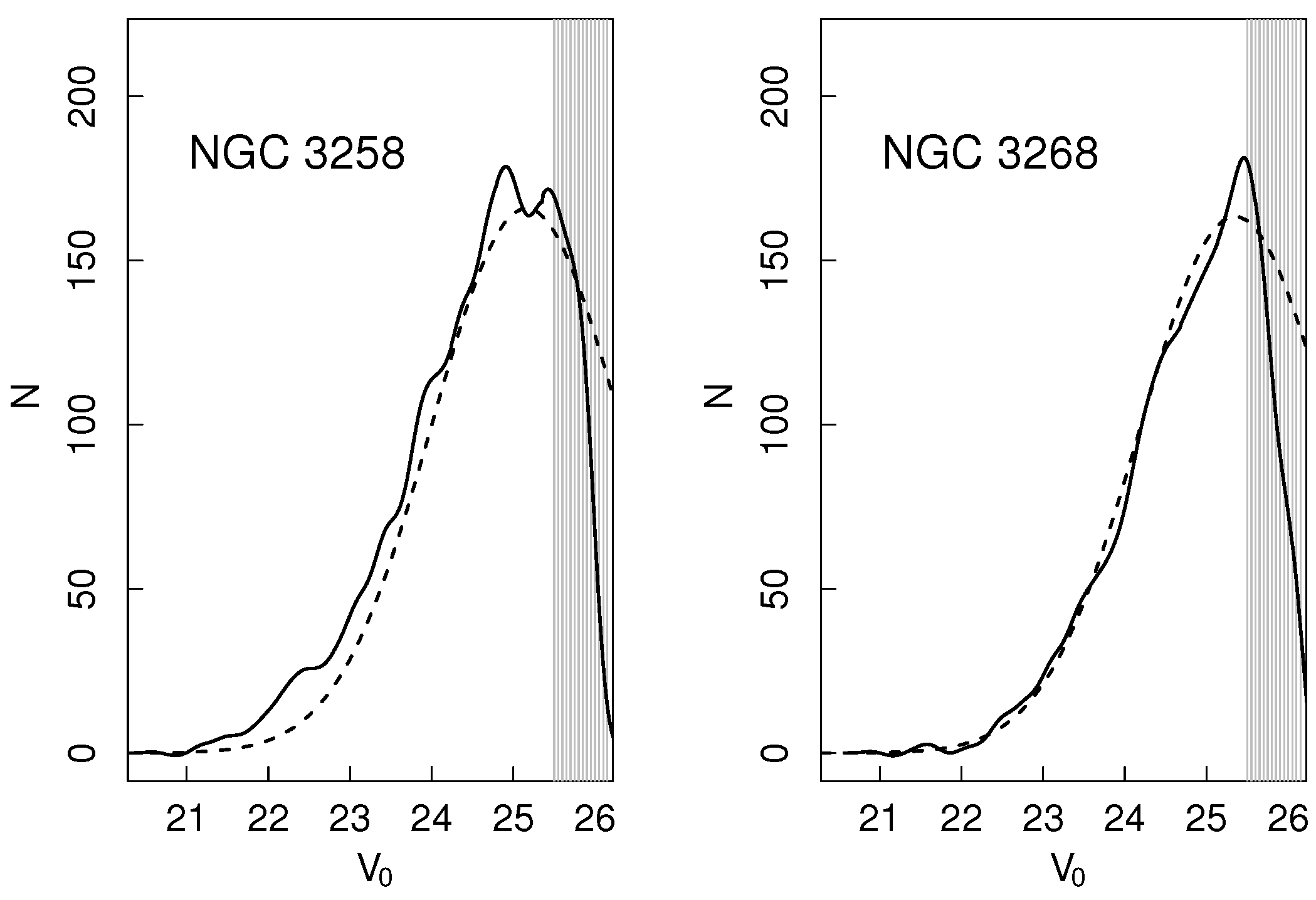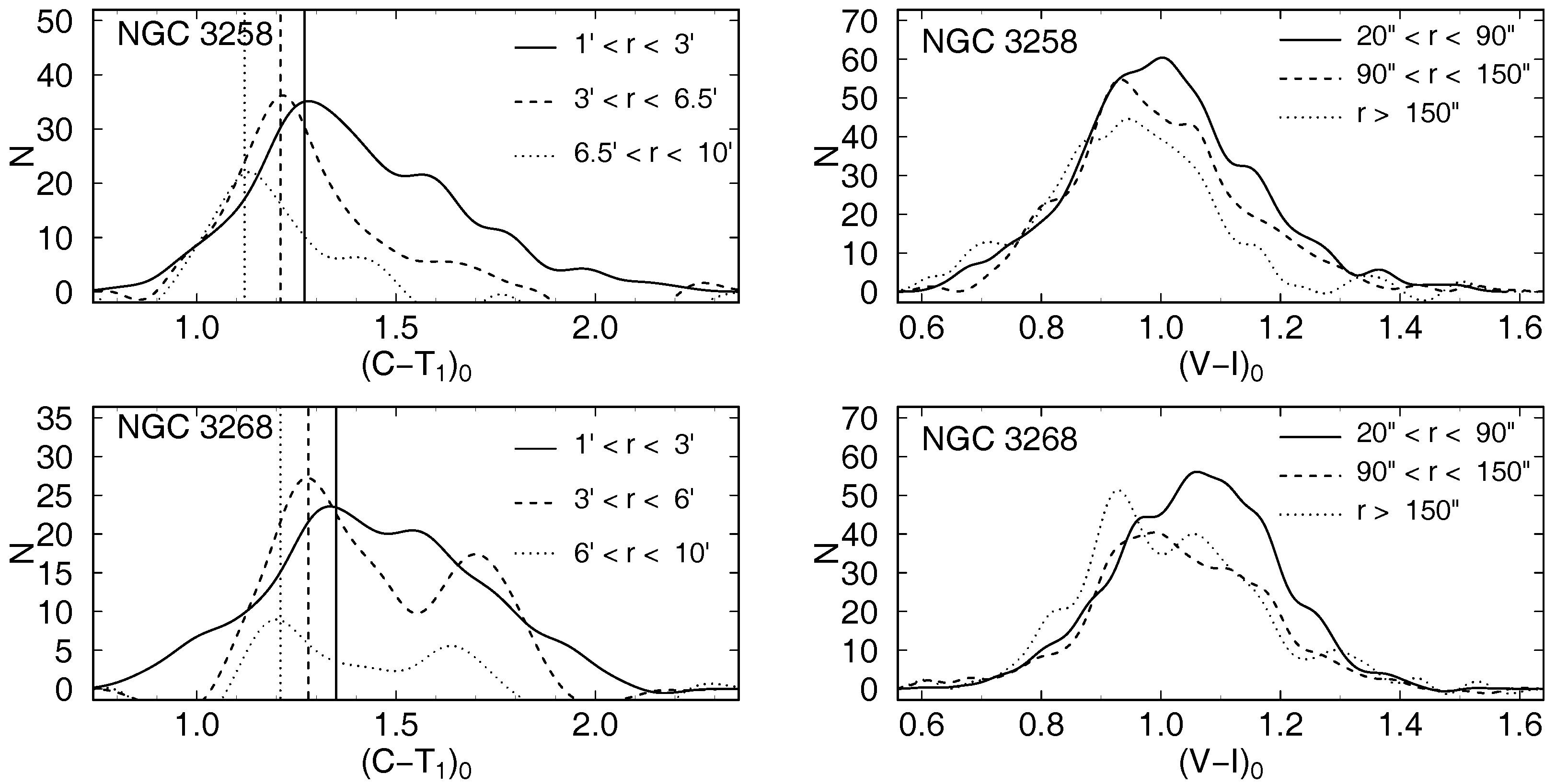Revisiting the Globular Cluster Systems of NGC 3258 and NGC 3268
Abstract
:1. Introduction
2. Materials and Methods
3. Results
3.1. GCSs Spatial Extension
3.2. Total Population of the GCSs
3.3. Radial Gradients in the Colour Distribution
4. Summary
Acknowledgments
Author Contributions
Conflicts of Interest
References
- Brodie, J.P.; Strader, J. Extragalactic Globular Clusters and Galaxy Formation. Ann. Rev. Astron. Astrophys. 2006, 44, 193–267. [Google Scholar] [CrossRef]
- Tonini, C. The Metallicity Bimodality of Globular Cluster Systems: A Test of Galaxy Assembly and of the Evolution of the Galaxy Mass-Metallicity Relation. Astrophys. J. 2013, 762, 39. [Google Scholar] [CrossRef]
- Kruijssen, J.M.D. Globular cluster formation in the context of galaxy formation and evolution. Class. Quant. Grav. 2014, 31, 244006. [Google Scholar] [CrossRef]
- Blakeslee, J.P.; Lucey, J.R.; Barris, B.J.; Hudson, M.J.; Tonry, J.L. A synthesis of data from fundamental plane and surface brightness fluctuation surveys. Mon. Not. Roy. Astron. Soc. 2001, 327, 1004–1020. [Google Scholar] [CrossRef]
- Cantiello, M.; Blakeslee, J.P.; Raimondo, G.; Mei, S.; Brocato, E.; Capaccioli, M. Detection of Radial Surface Brightness Fluctuations and Color Gradients in Elliptical Galaxies with the Advanced Camera for Surveys. Astrophys. J. 2005, 634, 239–257. [Google Scholar] [CrossRef]
- Tully, R.B.; Courtois, H.M.; Dolphin, A.E.; Fisher, J.R.; Héraudeau, P.; Jacobs, B.A.; Karachentsev, I.D.; Makarov, D.; Makarova, L.; Mitronova, S.; et al. Cosmicflows-2: The Data. Astron. J. 2013, 146, 86. [Google Scholar] [CrossRef]
- Hess, K.M.; Jarrett, T.H.; Carignan, C.; Passmoor, S.S.; Goedhart, S. KAT-7 Science Verification: Cold Gas, Star Formation, and Substructure in the Nearby Antlia Cluster. Mon. Not. Roy. Astron. Soc. 2015, 452, 1617–1636. [Google Scholar] [CrossRef]
- Caso, J.; Richtler, T. Deconstructing the Antlia cluster core. Astron. Astrophys. 2015, 584. [Google Scholar] [CrossRef]
- Dirsch, B.; Richtler, T.; Bassino, L.P. The globular cluster systems of NGC 3258 and NGC 3268 in the Antlia cluster*. Astron. Astrophys. 2003, 408, 929–939. [Google Scholar] [CrossRef]
- Bassino, L.P.; Richtler, T.; Dirsch, B. VLT photometry in the Antlia cluster: The giant ellipticals NGC 3258 and NGC 3268 and their globular cluster systems. Mon. Not. Roy. Astron. Soc. 2008, 386, 1145–1156. [Google Scholar] [CrossRef]
- Harris, W.E.; Whitmore, B.C.; Karakla, D.; Okoń, W.; Baum, W.A.; Hanes, D.A.; Kavelaars, J.J. Globular Cluster Systems in Brightest Cluster Galaxies: Bimodal Metallicity Distributions and the Nature of the High-Luminosity Clusters. Astrophys. J. 2006, 636, 90–114. [Google Scholar] [CrossRef]
- Caso, J.P.; Bassino, L.P.; Richtler, T.; Smith Castelli, A.V.; Faifer, F.R. Ultracompact dwarfs around NGC 3258 in the Antlia cluster. Mon. Not. Roy. Astron. Soc. 2013, 430, 1088–1101. [Google Scholar] [CrossRef]
- Caso, J.P.; Bassino, L.P.; Richtler, T.; Calderón, J.P.; Smith Castelli, A.V. Ultracompact dwarfs around NGC 3268. Mon. Not. Roy. Astron. Soc. 2014, 442, 891–899. [Google Scholar] [CrossRef]
- Mieske, S.; Hilker, M.; Misgeld, I. The specific frequencies of ultra-compact dwarf galaxies. Astron. Astrophys. 2012, 537, A3. [Google Scholar] [CrossRef]
- Norris, M.A.; Kannappan, S.J.; Forbes, D.A.; Romanowsky, A.J.; Brodie, J.P.; Faifer, F.R.; Huxor, A.; Maraston, C.; Moffett, A.J.; Penny, S.J.; et al. The AIMSS Project - I. Bridging the star cluster-galaxy divide. Mon. Not. Roy. Astron. Soc. 2014, 443, 1151–1172. [Google Scholar] [CrossRef] [Green Version]
- Caso, J.P.; Bassino, L.P.; Gómez, M. Globular cluster systems as tracers of the evolutionary history in NGC 3258 and NGC 3268. Mon. Not. Roy. Astron. Soc. 2017, 470, 3227–3238. [Google Scholar] [CrossRef]
- Bassino, L.P.; Faifer, F.R.; Forte, J.C.; Dirsch, B.; Richtler, T.; Geisler, D.; Schuberth, Y. Large-scale study of the NGC 1399 globular cluster system in Fornax. Astron. Astrophys. 2006, 451, 789–796. [Google Scholar] [CrossRef]
- Caso, J.P.; Richtler, T.; Bassino, L.P.; Salinas, R.; Lane, R.R.; Romanowsky, A. The paucity of globular clusters around the field elliptical NGC 7507. Astron. Astrophys. 2013, 555, A56. [Google Scholar] [CrossRef]
- Binney, J.; Tremaine, S. Galactic Dynamics. Nature 1987, 326, 219. [Google Scholar] [CrossRef]
- Elson, R.A.W.; Grillmair, C.J.; Forbes, D.A.; Rabban, M.; Williger, G.M.; Brodie, J.P. HST imaging of the globular clusters in the Fornax cluster-NGC 1379. Mon. Not. Roy. Astron. Soc. 1998, 295, 240. [Google Scholar] [CrossRef]
- Capuzzo-Dolcetta, R.; Mastrobuono-Battisti, A. Globular cluster system erosion in elliptical galaxies. Astron. Astrophys. 2009, 507, 183–193. [Google Scholar] [CrossRef]
- Brodie, J.P.; Romanowsky, A.J.; Strader, J.; Forbes, D.A.; Foster, C.; Jennings, Z.G.; Pastorello, N.; Pota, V.; Usher, C.; Blom, C.; et al. The SAGES Legacy Unifying Globulars and GalaxieS Survey (SLUGGS): Sample Definition, Methods, and Initial Results. Astrophys. J. 2014, 796, 52. [Google Scholar] [CrossRef]
- Jordán, A.; McLaughlin, D.E.; Côté, P.; Ferrarese, L.; Peng, E.W.; Mei, S.; Villegas, D.; Merritt, D.; Tonry, J.L.; West, M.J. The ACS Virgo Cluster Survey. XII. The Luminosity Function of Globular Clusters in Early-Type Galaxies. Astrophys. J. Suppl. 2007, 171, 101–145. [Google Scholar] [CrossRef]
- Muratov, A.L.; Gnedin, O.Y. Modeling the Metallicity Distribution of Globular Clusters. Astrophys. J. 2010, 718, 1266–1288. [Google Scholar] [CrossRef]
- Strader, J.; Brodie, J.P.; Forbes, D.A. Metal-Poor Globular Clusters and Galaxy Formation. Astron. J. 2004, 127, 3431–3436. [Google Scholar] [CrossRef]
- Peng, E.W.; Jordán, A.; Côté, P.; Blakeslee, J.P.; Ferrarese, L.; Mei, S.; West, M.J.; Merritt, D.; Milosavljević, M.; Tonry, J.L. The ACS Virgo Cluster Survey. IX. The Color Distributions of Globular Cluster Systems in Early-Type Galaxies. Astrophys. J. 2006, 639, 95–119. [Google Scholar] [CrossRef]
- Forbes, D.A.; Spitler, L.R.; Strader, J.; Romanowsky, A.J.; Brodie, J.P.; Foster, C. Evidence for two phases of galaxy formation from radial trends in the globular cluster system of NGC 1407. Mon. Not. Roy. Astron. Soc. 2011, 413, 2943–2949. [Google Scholar] [CrossRef]




| Name | Obs. Date | Exp. Time | Typical |
|---|---|---|---|
| MOSAIC data | |||
| Central Field | April 2002 | s in s in | |
| East Field | May 2004 | s in s in | |
| FORS1 data | |||
| March 2003 | s in s in I | ||
| NGC 3258 | NGC 3268 | |||
|---|---|---|---|---|
| Blue GCs | Red GCs | Blue GCs | Red GCs | |
| a | ||||
© 2017 by the authors. Licensee MDPI, Basel, Switzerland. This article is an open access article distributed under the terms and conditions of the Creative Commons Attribution (CC BY) license (http://creativecommons.org/licenses/by/4.0/).
Share and Cite
Caso, J.P.; Bassino, L. Revisiting the Globular Cluster Systems of NGC 3258 and NGC 3268. Galaxies 2017, 5, 48. https://doi.org/10.3390/galaxies5030048
Caso JP, Bassino L. Revisiting the Globular Cluster Systems of NGC 3258 and NGC 3268. Galaxies. 2017; 5(3):48. https://doi.org/10.3390/galaxies5030048
Chicago/Turabian StyleCaso, Juan Pablo, and Lilia Bassino. 2017. "Revisiting the Globular Cluster Systems of NGC 3258 and NGC 3268" Galaxies 5, no. 3: 48. https://doi.org/10.3390/galaxies5030048





